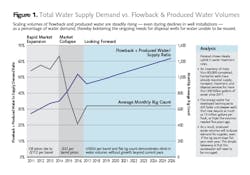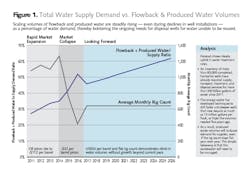Energy Market Rebound Signals Opportunity for Water
By Reese Tisdale
Energy markets are trending upward, with oil prices now topping US$60 a barrel, and water sector players are expected to gain. This rebound, from the industry’s collapse a few years ago, has thrust upstream oil and gas into a new phase, one in which water services are even more critical to oilfield operations and costs. As long as energy markets remain stable, opportunity for improved water management solutions is there for the taking.
At the center of this wave of drilling activity is the hydraulic fracturing segment of the market, which has captured enough market share to influence global markets. Highlighting this shift, the U.S. is on pace to eclipse Saudi Arabia’s almost 10 million barrels per day output by year-end 2018, kick-starting demand for water management solutions.
As Bluefield tallies the final numbers coming in from 2017, water management spend from upstream oil and gas is on track to surpass the $136 billion forecasted 2017 to 2026. This growth comes on the heels of a U.S. horizontal rig count that has climbed past 650, up from a monthly average of 414 in 2016. An inventory of more than 83,000 completed horizontal wells have already required supply, transport, treatment, and disposal services for more than 350 billion gallons of water since 2011.
At the same time, increased innovation in the hydraulic fracturing sector is paying dividends, including techniques to drill faster and generate more production per well. Both of these production improvements are having collateral impacts on water spend. Demand for water solutions is rising exponentially. In some basins, well completions require as much as 12 million gallons of water per well — triple the water volumes needed five years ago, heightening scrutiny on water usage and reuse in select basins.
According to Bluefield’s analysis, energy companies spend will average almost $14 billion annually from 2017 to 2026 on water management, including water supply, transport, storage, treatment and disposal.
In this second phase of expansion, beginning from its 2017 nadir in oil prices, oilfield service providers are ramping up production and establishing more mature supply chains. Within water management, business models are shifting to tie supply, treatment for reuse, and disposal across well pad networks. Rather than relying on trucks, which represent approximately 60 percent of spend to date and traditionally allow for contract flexibility in the event of a market downturn, firms are gambling in harder infrastructure and continued market expansion.
The growing water demand from the fracking sector is forcing energy services players to look to municipal reclaimed water in order to secure supplies for operations. At least five midstream operators have already signed purchase agreements with local municipalities in Texas and Oklahoma.
Horizontal drilling activity, particularly in the Permian Basin in West Texas, continues to drive a wave of midstream water investments and new business models focused on the hydraulic fracturing sector’s critical ingredient: water. Several firms, including Antero Midstream, Noble Midstream, Rice Midstream, and NGL Energy, are poised to benefit from their production companies’ energy positions.
A number of private-equity-backed firms are positioning to address the sector’s water challenges through pipelines, treatment, and disposal. In 2017, we saw private-equity-backed H2O Midstream acquire produced water infrastructure assets from Encana Oil & Gas. In addition, Layne Christensen launched a new energy infrastructure business, including construction of a new high-capacity water pipeline and infrastructure system to serve energy producers in West Texas. IWW
About the Author: Reese Tisdale is president of Bluefield Research. He has an extensive background in industry research, strategic advisory, and environmental consulting for both the water and energy industries. He can be reached at [email protected].

